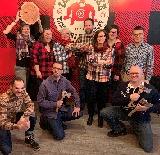Blog
Unless otherwise stated, content is shared under CC-BY-NC Licence
Enabling reconciliation in Canada: the value of digital preservation
Kelly Stewart is Chief Archivist at Artefactual Systems Inc.
There are many ways to describe the value of digital preservation, but for me it’s fundamentally about enabling memory in the modern world. Whether we want to hold those in power to account for the actions they have taken or use those records in new, previously unimagined or impossible ways as science, culture, and technology evolve, access to reliable and trustworthy digital records is a cornerstone to our collective memory.
Breaking Down Barriers: Collaboration at the University of Calgary Libraries and Cultural Resources
Eilzabeth-Anne Johnson is Electronic Records Archivist at University of Calgary Libraries and Cultural Resources.
At the University of Calgary Libraries and Cultural Resources (LCR), we're in the process of developing our digital preservation program. As part of this undertaking, we've been breaking down the barriers of the ways we communicate with each other and with our colleagues, patrons, and donors outside the institution. Acquiring, cataloguing, migrating, and sharing our digital material all comes with challenges. Learning how best to communicate with colleagues in different departments and with different areas of expertise has been crucial for our projects. While digital preservation can seem like the domain of only archives and libraries, LCR operates eight University of Calgary libraries on campus and across the city. Included in LCR are two art galleries: the Nickle Galleries and the Founders' Gallery at The Military Museums, as well as Archives and Special Collections, the University of Calgary Copyright Office, Research Data Centre and the University of Calgary Press. All these units create born-digital material.
Fixity When Nothing is “Fixed” - Reflections on Upstream Engagement and Digital Preservation
Angela Beking is Data Policy and Research Analyst/Analyste des politiques et de la recherche en les données at Privy Council Office/Bureau du Conseil privé (Canada).
We often speak of the critical importance of upstream engagement in digital preservation work. If we wait until the end of the records lifecycle to begin speaking with Producers about the opportunities provided by digital preservation, we are often too late. That box of unreadable floppy disks. Those files in a format that is not recognizable, let alone readable. That information that was stored on a social media platform, thinking it would be around forever (looking at you, Google +). All of these examples speak to the need for active and engaged digital preservation practice.
But how do we actually “do” upstream engagement? What value can we deliver to Producers, and what can we learn in return? I suggest that there are lessons to be learned in breaking down barriers through upstream engagement that will encourage – or even require – our discipline to reflect on its core assumptions.
Perishable Knowledge: Why digital preservation matters for accessibility
Christopher Zaste is a Digital Archivist at the University of Manitoba.
On September 30th of this year, Canada held its first National Day for Truth and Reconciliation. Throughout the nation, one could see people wearing orange shirts wherever they went. Old, young, Indigenous, non-Indigenous, people of all backgrounds donned this shirt to remember residential school Survivors. While the number of orange shirts are plenteous, the number of residential school Survivors are not. Each year, their number steadily decreases. While archivists preserve the written record in archives, society loses the firsthand experience of those who went to residential school. Human knowledge has a shelf life, and it is the lifespan of the person holding it.
With the loss of this knowledge, people will lose the opportunity to learn about what happened from those who experienced residential schools firsthand. The same can be said for the loss of knowledge for other marginalised groups as their truths often vanish when one of their number passes away. This is a perspective that is not present in the written record, which non-community members often wrote. With its loss, entire communities can lose their voice in history.
We need application signatures! Automating access via emulation with application signatures
Euan Cochrane is Digital Preservation Manager at Yale University Library.
As part of the EaaSI program of work we are aiming to make it as easy as possible to use emulation for long term digital access. One goal we’re trying to achieve is to enable users to automatically open digital objects in their original interaction software. We hope this will break down barriers to the use of emulation and preserved software in long term access contexts.
We currently have a prototype of the Universal Virtual Interactor (which is what we call the tool that automates the automated opening process) that uses file format information and other metadata to match digital objects to interaction software. It assumes that a file matching a specific file format signature (when scanned with a format identification tool), should be opened with the software for which that format was the default, and which was available when the file was created. Even then it reports multiple matches and attempts to order them by best fit/most likely to be “original” (based on dates, etc).
Web Archiving the 2021 Federal Election at Library & Archives Canada – A Look Behind the Curtain
Emily Monks-Leeson, Russell White and Kevin Palendat from Library & Archives Canada.
On September 20, 2021, Canada held its 44th federal election following a 36-day campaign. As Canadians turned to their preferred news and social media outlets, Library and Archives Canada's Web and Social Media Preservation Program began crawling and preserving election-related websites as events unfolded online. This was the sixth election LAC had captured through web archiving, and when it comes to the dynamic nature of such a task, we’ve found that frequency is a friend. We had a background of knowledge and experience to draw on, dating back to 2006 when we archived a modest 21 websites totaling 23 GB of data. Our efforts have intensified with each election to the point where, in 2021, we have crawled over 300 seed URLs totaling around 1.5 TB of data (and counting).
Digital preservation of digital documents of an NGO in Mexico
Claudia Muñoz López is a student of the master’s degree in Library and Information Studies at the National Autonomous University of Mexico.
The following blog is available in Spanish below.
Non-governmental organizations are non-profit associations that provide services to society on the most diverse purposes: education, culture, human rights, environment, hospital aid or support to vulnerable communities, among many others. Their activities have an impact on society and the communities with which they work.
As organizations, documents recording their activities are useful both for the efficiency of the organization itself and for society so that it can understand its history and social, cultural and political influence. However, what happens when most of these documents are digital and do not have a digital preservation plan? E-mail, websites, databases and multimedia files are widely used documents that reflect the day-to-day work of organizations and do not have a paper version.
Generating value with digital preservation in the National Library of Mexico
Ana Yuri Ramírez-Molina, Alberto Castro Thompson, Lisandro Pablo Olivares, Coordinación de Innovación y Estrategia Digital de la Biblioteca Nacional de México.
Due to the events of the pandemic, in Mexico and all around the world, people have modified the way they work and communicate and have turned to new technologies that facilitate digital connections. These technologies are important in the teaching and learning process and can have a significant social impact if used in education as a means of achieving social development. Institutions in charge of safeguarding the knowledge generated by the society play a key role in this permanent process of human development, as they are holding responsibility of ensuring continuity of digital heritage materials as long as they are needed.
See a barrier? Let's knock it down...
Nancy McGovern is Director of Digital Preservation at MIT.
WDPD’s theme Breaking Down Barriers is perfect for this year! I know I’ve been working on all kinds of barriers this year. These are some of my barrier busting examples from this year:
ICA Managing Digital Archives course: This one comes first because it’s the most recent – it’s launching today! It’s been so rewarding to collaborate with Margaret Crockett at ICA, my co-creator, with significant contributions from Kari Smith of Global Archivist. One of our objectives was to help organizations with limited resources, a common barrier, to build their capacity by providing an accessible and comprehensive course that is lifecycle-based and grounded in standards and good practice. More info here: https://www.ica.org/en/ica-online-course-managing-digital-archives
Building bridges with the Big Data of the Past
This post was written by the team of the Time Machine Organisation.
This year´s World Digital Preservation Day’s theme “Breaking Down Barriers” points to how digitisation is the road into the future and holds numerous opportunities in various areas. Moreover, “the aim of World Digital Preservation Day is to create greater awareness of digital preservation that will translate into a wider understanding which permeates all aspects of society – business, policymaking, personal good practice” (cited from dpconline.org) – a conviction that is shared by the Time Machine network and that we would like to outline for you on this occasion.






















































































































































